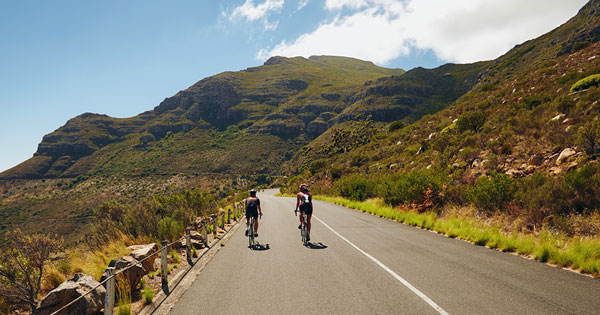Coaches are always saying hills are “speedwork in disguise,” and they’re right. There’s no hiding the truth though, running up hills is tough. Even at a recreational pace they make us tired, and easily fatigue our legs as much as any speed work. That said, if you’re going to run a race, chances are you’re going to have to run at least one hill. For most of us, this hills scares us because we consider them to be the “achilles heel of our running.”
But, what if you could turn hills into a strength, be potentially faster and become a better runner just by incorporating them into your running routine?
Need any more reasons to start falling in love with hill training to improve your running? We’ll give you a couple huge benefits:
- Works your aerobic and anaerobic systems without requiring you to increase your speed. All you have to do to feel the aerobic and anaerobic benefits is check your heart rate at the top of a hill on your next workout.
- Hills are great resistance training for your legs. Not only are your legs propelling you forward, but they are being challenged to push up against gravity. The increased power provided from running hills translates directly into your speed.
- You’ll reap the rewards of a higher lactate threshold because hills help increase your ability to resist fatigue in races and long runs, as well as help muscles tolerate higher levels of lactic acid.
- Not only will you become fitter and faster, but your running mechanics will benefit from running on hills. Uphill running encourages the muscles that help propulsion to fire better (Glutes, Calves, Quads), while encouraging the hamstrings to relax. Basically, teaching the hamstrings to relax minimizes over striding and breaking forces–impact during your footstrike.
- The “toe-off” phase of uphill running provides the perfect position of “Triple Flexion” where all three major joints of the lower body are flexed (ankle dorsi flexion, knee flexion, and hip flexion). I’ve worked with countless athletes on creating the ability to incorporate this range of motion in each of these joints while running on the flat surfaces, and found little results until… we ran hills. After just a couple of weeks of hills, we saw a huge improvement in nearly all of their running form.

Now, you’re probably reconsidering adding them to your training. Great! Here are some guidelines that I use when planning hill running into any athletes training plan.
- Regular hill training sessions of 1-2 times per week for 6-8 weeks will be effective for improving your ability to create speed and strength.
- Taking a page from Arthur Lydiard, the great New Zealand running coach, “I always prescribe hill running in the beginning of a training plan.” For an athlete in a 16-20 week training plan, that would be the first 6-10 weeks (6-8 for distances up to 1/2 Marathon, and 10 for the Marathon) during your Base Training Phase.
- In most instances, you load up with longer hills at the start of this training phase (Base Training), and finish with shorter hills as you progress through your 6-8 weeks of hills. You could find coaches that do this either way, short hills first, or long hills first. There are good reasons to support both approaches. I prefer long hills at the start of this phase, and short hills towards the end because it helps my athletes transition easier to speed work on the road. . Since the shorter hills are run at a slightly higher intensity, they more closely mimic the leg speed of road or track work.
- Short hills are hills that take 2:00 mins or less to run up at 10K effort. Longer hills are hills that take 2-5 mins to run up at tempo or 1/2 marathon effort.
- A great place to fit in the second hill run is during your long run, or a mid-week semi-long run. Why? This way it doesn’t interfere with your other workouts and rest days.
- Hill training is easy to do from your front door. They don’t require a track or measured distance, and they are “open” and available at all hours of the day.
- An important note of caution is to remind you that all good things should be enjoyed in moderation. It is important to make hill running a portion of your weekly running, but not to make all of your running into hill running.

What does a hill run, or workout look like?
Excellent question. The most common type of hill workout is running “hill repeats.” Just as the name infers, to perform a hill repeat you run up a hill, and jog back down, and then repeat the process. Most hill repeat workouts use a high amount of effort on the uphill, and the downhill jog to catch your breath and lower your heart rate.
One cycle of this process is called a repetition, or “rep.” A typical “hill repeat” workout would look something like this:
Warm up with a mile or two finishing at the bottom a hill (see the guidelines above to help decide what type of hill). After your hill repeats you would run a 10-20 min cool down on a flatter surface.
The number of repeats that you should perform depends on your experience and fitness levels:
- Beginner runners should start with two to three repeats, and add an additional “rep”each additional week.
- More advanced runners can start with four to six repeats and add another rep each week, with a maximum of ten repeats.
- Runners who start with longer hills should start with the lower number of reps. If you start with short hills, use your discretion and start with either number of reps.
One more big reason to start hill training… The beauty of hill running shines through in the flexibility of these workouts. Unless you live in Florida there are hills everywhere. (Sorry Florida, we still love Disney.) However, if you do find yourself in area that’s just too flat to have any hills, or you live in an urban area where you can’t string together a full hill without stoplights, you can still do hill workouts.
These are some great alternatives that mimic hill workouts:
- Treadmill Repeats
OK, the monotony of the treadmill is not always my favorite either. Putting that aside, unlike the outdoors, you can be exact on the duration and elevation of each repeat. In fact, most treadmills have built in hill workouts. Some treadmills can even simulate downhill running.
- Stair Repeats
Just find the nearest or tallest building you can and run up and down the stairs for the same amount of time as you had planned for your hill repeats. Stairs are a great way to encourage that high knee lift, and they can be just as relentless as most hills. One of the great things about running stairs is that you can get extremely creative with these workouts. You can use a any large building, reminisce about high school by running in a stadium, or sometimes jog down the hall of your hotel and use the stairs in their fire escape. Just be sure that if you use the stairs in the fire escape at your hotel that you don’t set off the alarm!
- Beach Running
The resistance of the soft sand can work your legs extremely well. I suggest alternating running at a high intensity for a short distance in the soft sand with jogging on the hard pack at an easy effort approximately twice as long for your recovery interval.
So if you’ve been spending time figuring out how to run around hills, instead of up them. Stop. Hills will make you a better runner, so start embracing them and seek them out! Once you start incorporating them a couple of times a week, hills will go from your achilles heel to your new secret weapon.



